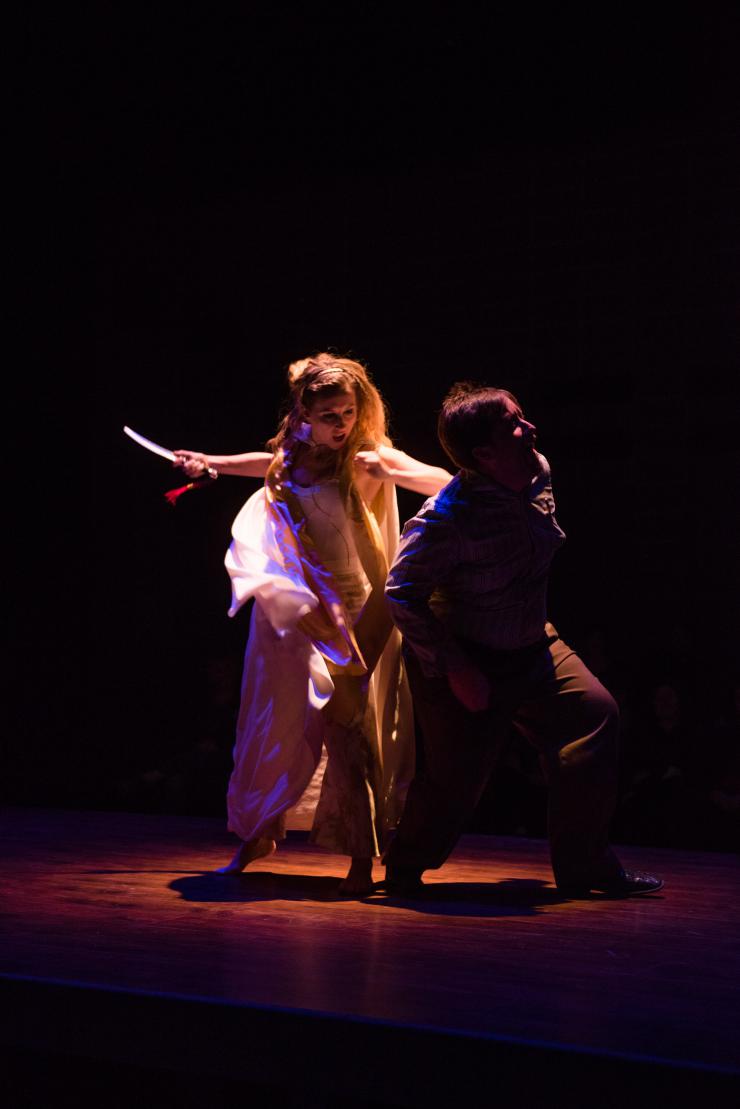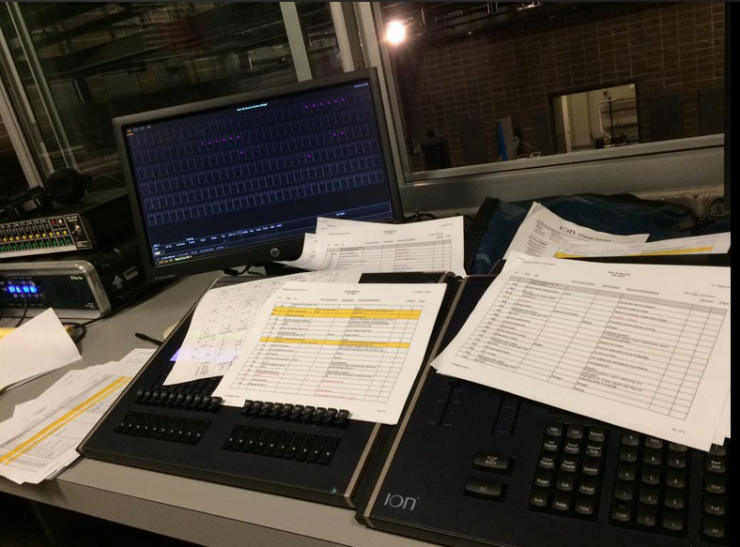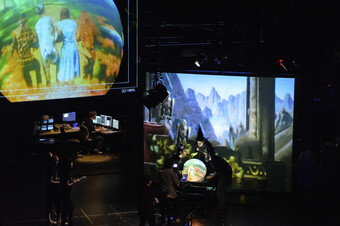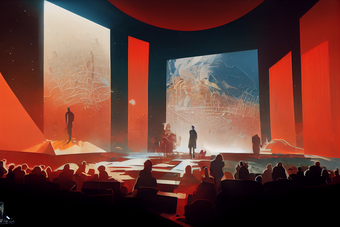When the Gods Choose a Different Play Each Night
Designing for Interactive Theatre
When Liz Fisher and Robert Matney of Whirligig Productions approached me about designing lights for their new and innovative version of the House of Atreus story, I jumped at the chance, knowing that I was taking on a rather large project and having no idea how I was going to tackle its challenges. Deus Ex Machina is an interactive retelling of the Oresteia—interactive in that, at key points in the play, characters go to an oracle to seek guidance, and the audience gets to select the prophecy that pushes the characters into their next course of action. It was formatted and marketed as a “Choose Your Own Adventure” style play. The choice that the audience democratically made would alter the course of the narrative—does Clytemnestra seek vengeance for the death of Iphigenia? Turn to page 256.
What does it take for an indie theatre company to mount such an ambitious project? We were literally putting ourselves in a position where we were not going to know what play we were doing at the start of the night. We were putting the audience in complete control.
Here is what this means for a lighting designer: the audience can choose from one of two prophecies for Clytemnestra, which splits the narrative into two possible paths (we will only go down one in any given performance); the same is true of Electra in each of those paths, giving us now four possible paths; Orestes, in each of those four paths, can be given one of three prophecies. Twelve paths. Twelve entirely independent plays.
Flexibility, flow, detachment. This show nearly made a Buddhist out of me.
No other production that I have ever worked on emphasized more the need for a clear design process; no other production ever forced me to be less precious about my choices, less attached emotionally to certain cues. I’m a designer who creates spreadsheets of potential lighting cues before tech; this was a show that all but required this, as well as flowcharts demonstrating how we were going to navigate the large number of cues programmed into the board. Not only was I required to remain unattached to my work—I had to remain unattached to the entire concept of a tech rehearsal! We loaded in on a Monday, and opened on a Saturday. A friend of mine who had worked on a similar project advised me over the summer to make time to tech each iteration on its own. Given our time constraints, and later technical hurdles, this was never going to be possible. The entire tech week required everyone to go with whatever flow was necessary that day—plans were discarded on a daily basis based on what the tech and the actors (who were preparing seven and a half hours of text) needed most.

Flexibility, flow, detachment. This show nearly made a Buddhist out of me.
When I think about productions I’ve seen that required audience interaction of some sort, the design elements tend to be simple. There are any number of reasons for this— experimental companies producing this kind of work might not have the budget for complex designs, or more often the choice to keep the design simple allows the company to focus on other elements of the play that have more importance—but this particular production specifically didn’t want to do that. The key to Deus Ex Machina’s audience involvement lay in technology that was being developed by company members Robert Matney and Tim Thomas. This technology would allow the audience to vote for their preferred prophecy at each fork in the road via their cell phone, the results projected on screens built into the set. In the words of Thomas,
The technology builds upon basic web technology. Each screen is simply projecting a full screen web browser…we use WebSockets to tell the screens when to display voting elements and when to change…we chose text messaging because it was the most accessible option. Something like 87 percent of Austin residents have the ability to send and receive text messages. It also has a built in aspect of one phone number, one vote. No need to have users create accounts for the show. We’d like to eventually add voting by other means, but SMS [short message service] is very simple.
What that boils down to: the audience was given the power to text the gods. The program, dubbed “Mt. Olympus,” would take in all of the text messages and determine which prophecy was the most popular, announce the prophecy, and set us on a new path. Since so many resources were being devoted to developing Mt. Olympus as the pivotal piece in this show, it never made sense to strip down the design elements. Deus Ex Machina was never meant to be that kind of show.
When the show closed, only six of the possible twelve “paths” had been performed; all lighting and projection cues that would have been executed on one of the other paths were never seen. One of the unseen endings contained a beautiful piece of choreography, set to a piece of original music. It never made it in front of an audience.
From the start, I knew that I was designing twelve separate shows. While any path involved some amount of duplication from other parts of the script (all versions had Zeus interrupting Electra’s oracular moment with almost the same speech), I didn’t want to rely on using the same design for each path regardless of the choice made. If Clytemnestra chooses to not kill Agamemnon, we are now in a completely different world, and even though moments might have been repeated in other “timelines,” the design itself needed to reflect the character’s choices in this timeline. In this sense, the element of audience choice multiplied my workload significantly. The final lighting design involved 670 light cues programmed into the board (an ETC Ion) with about 200 of those cues being seen in any given run. This is a lot of cues for me, as a designer; I’m not the “big musical” type of designer, and the last lighting design I did of Macbeth had about 250 cues in it.


It wasn’t just the sheer quantity of light cues that was made complicated by the element of choice—the operation of the show, setting up how I was going to cue the show and how an operator would run it was also affected. Usually when I create a design, it’s as straightforward and linear as the script—the preshow and house are up in cue 1, and we go through each cue in sequential order until the final one, house up at the end of the show. Deus Ex Machina required the designer, operator, and stage manager to be able to make decisions about which parts of the design to execute. This happened not only in the oracular moments in the play, but also in several other smaller choices that occasionally affected light cues. In one particular moment, the audience is asked whether or not a character should sing to lighten the dark, dreary mood—a yes vote meant the operator brought up a light on the actor that would not have been seen for a no vote. The show also contained a couple of “easter eggs,” hidden extras that had to be discovered and solved by intrepid audience members, some of which would trigger additional light cues. All of these elements had to work as one coherent lighting design for twelve separate plays. Lights stand by with Apollo sunburst cue…maybe…or not…no, nevermind.
Lowell Bartholomee, the show’s projection designer, saw another way in which our work was affected: the design had to prepare for any eventuality in the production, and each night only a fraction of what had been designed would be shown. Essentially to Bartholomee this meant “with Deus there's a requirement to be rather zen and let things go…realize that this one video piece that took X amount of time to shoot, X amount to process and finalize…may never be seen by an audience.” When the show closed on January 18, 2015, only six of the possible twelve “paths” had been performed; all lighting and projection cues that would have been executed on one of the other paths were never seen. One of the unseen endings contained a beautiful piece of choreography, set to a piece of original music. It never made it in front of an audience.
Initially, the intention was to incorporate sound and projection cues into the Mt. Olympus system itself. We never discussed doing this with lighting (I’m not going to add the extra layer of complexity of integrating the board with the new program to the already Herculean effort of my first interactive theatre design—let’s do that next time!). Any software developer knows that rolling out a new product involves glitches and setbacks. During our tech week, we experienced our fair share of these, and this led to the decision to offload the sound and video content to QLab (a multimedia playback software), allowing those elements to be run separately as they would during a “normal” show. It would be truly fantastic in a future iteration to make the sound, video, and lighting elements fully integrated and triggered by the audience’s decisions, but that did not happen this time.
While costume designer Jamie Urban and scenic designer Justin Smith did not have quite the same challenges facing the lighting, sound, and video designers, their jobs were not easier. The systems of organization created backstage in order to facilitate movement of props and changes of costume at a moment’s notice were a thing of beauty. Urban’s wardrobe team restructured the way in which they had planned to work backstage specifically for this show. Wardrobe crew standby—Electra is about to fast-forward eight years. Or not. We don’t know yet. The props crew had about one hundred envelopes taped to walls at the start of the show each night, I remain completely clueless as to their function. Production assistant Brooks Naylor taped a fresh map of the play to the wall in the green room each night, and tore off the parts that we were not doing as each vote came in. Smith created the Palace at Argos such that it looked towering and impressive but also served as a great projection surface for the oracle. His choices of colors and textures were narrowly constrained by the other tech needs of the show.
What does it take for an indie theatre company to successfully mount a production of this size, with this much technology and design built in? We essentially had to work as a machine ourselves. Decisions had to be made quickly and executed as soon as the crew could do it in order to keep the process moving forward. Designers had to be willing to cut or completely rework what they were doing at a moment’s notice for the “greater good” of the show as a whole. We had to be fully supportive of the work that every other artist was producing for the show and ready to accommodate their needs. Turning over our play to the audience each night was a lot like turning our fates over to the gods at the Oracle. Terrifying, exhilarating, and not always with the result that we wanted. But we obey the will of the gods.
(Note to readers: any stage management “calls” made above are the sole creation of me, a lighting designer. Our actual stage manager Stephanie Delk would have called those moments far more deftly.)
Deus Ex Machina was livestreamed via HowlRound TV.








Comments
The article is just the start of the conversation—we want to know what you think about this subject, too! HowlRound is a space for knowledge-sharing, and we welcome spirited, thoughtful, and on-topic dialogue. Find our full comments policy here
Back in the 70s "Zen and the Art of Motorcycle Maintenance" actually showed me how to be a designer. I knew only tension, fear and frankly horror in the face of technical intransigencies as I began designing shows. That book gave me the kind of calm organisational and forgiving attitudes you write about here. And I hope one day Whirligig gets to show all that work they made. Theatre is ephemeral, fleeting, but never to be seen at all is too sad.